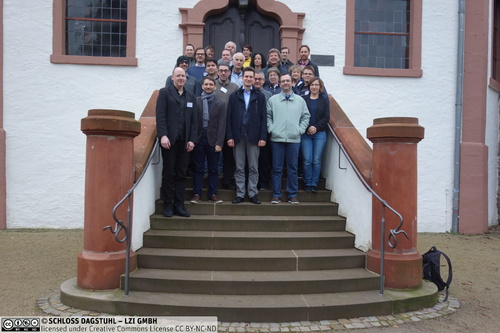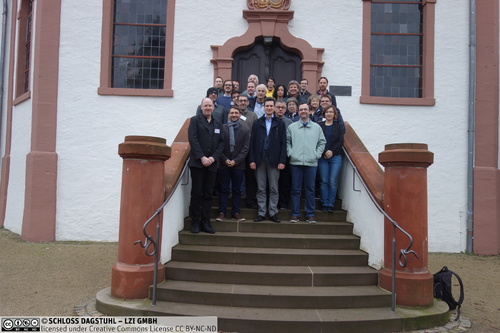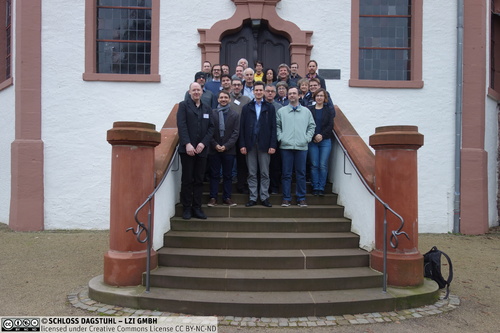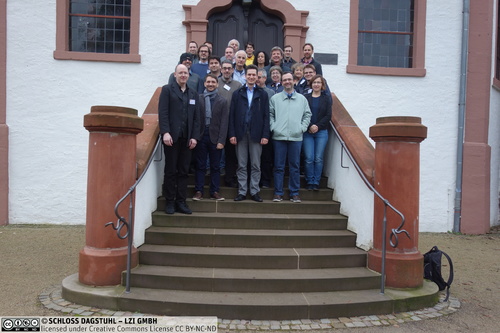Dagstuhl-Seminar 17492
Multi-Level Modelling
( 03. Dec – 08. Dec, 2017 )
Permalink
Organisatoren
- João Paulo Almeida (Federal University of Espírito Santo - Vitória, BR)
- Colin Atkinson (Universität Mannheim, DE)
- Ulrich Frank (Universität Duisburg-Essen, DE)
- Thomas Kühne (Victoria University - Wellington, NZ)
Kontakt
- Andreas Dolzmann (für wissenschaftliche Fragen)
- Annette Beyer (für administrative Fragen)
Impacts
- Multi-dimensional multi-level modeling : article - Kühne, Thomas - Berlin : Springer, 2022. - pp. 543-559 - (Software and systems modeling ; 21. 2022,2).
- Multi-Level Constraints : article in MODELS-WS 2018 - Clark, Tony; Frank, Ulrich - Aachen : CEUR, 2018. - pp. 103-117 - (CEUR workshop series ; 2245).
- The Flexible Multi-Level Modelling and Execution Language (FMMLx) - Frank, Ulrich - Duisburg : Universität , 2018. - IV, 67 pp. - (ICB Research Reports - Forschungsberichte des ICB ; 66).
- Toward a Unified Conception of Multi-Level Modelling: Advanced Requirements : article - Frank, Ulrich - Aachen : CEUR, 2018. - pp. 718-727 - (CEUR workshop series ; 2245).
Programm
Multi-Level Modeling (MLM), i.e., the explicit exploitation of multiple levels of classification when modeling, represents a significant extension to the traditional two-level object-oriented paradigm with the potential to dramatically improve upon the utility, reliability and complexity level of models. It therefore has benefits in many domains of modeling such as software engineering, process modeling and enterprise modeling. Research into multi-level modeling has increased significantly over the last few years, manifesting itself in lively debates in the literature, three international workshops (MULTI 2014–2016), a published journal theme issue (SoSyM), a special issue for the EMISA journal (in preparation), and a growing number of tools and languages. However, while the enthusiasm around MLM provides momentum to this promising research area, the recent speed of growth and the focus on exploring new language features has raised some challenges, including the following:
- growing diversity of approaches. On the one hand diversity is welcome in order to spawn a competition of ideas but on the other hand it can slow down the approach’s growth and industry adoption unless steps are taken to consolidate ideas and bundle resources.
- neglect of real world applications. It is natural to initially focus on core principles when developing a new approach, but at some point it becomes important to make the transition into industrial practice in order to validate claims about the utility and need for MLM, and to promote the uptake of MLM in new domains and industries.
- lack of integration with related disciplines. In particular, ontology engineering has overlapping application areas and could form a powerful synergy with MLM due to its complementary strengths and weaknesses. However, areas such as logic, philosophy, and linguistics are also highly relevant for the further advancement of MLM.
In order to address the aforementioned challenges the seminar will bring together researchers and industry practitioners from the areas of conceptual modeling, ontologies, and formal foundations in order to pursue the following key goals:
- explore synergies between MLM and ontology engineering.
- collect evidence about the real-world relevance of existing MLM approaches and analyze their potential deficiencies.
- identify objective criteria for comparing competing approaches, e.g., by developing respective benchmarks in cooperation with modelers from industry.
- target enterprise modeling with a view to paving the way for transitioning MLM into industrial practice.
- develop novel approaches for MLM and strengthen its formal foundations.
- find more effective ways of disseminating MLM research, e.g., by creating an MLM compendium and/or promoting the use of common resources like the Multi-Level Modeling Wiki, and maintainig a web-based repository for multi-level models
 João Paulo Almeida, Colin Atkinson, Ulrich Frank, and Thomas Kühne
João Paulo Almeida, Colin Atkinson, Ulrich Frank, and Thomas Kühne
Multi-Level Modeling (MLM), i.e., the explicit exploitation of multiple levels of classification when modeling, represents a significant extension to the traditional two-level object-oriented paradigm with the potential to dramatically improve upon the utility, reliability and complexity level of models. It therefore has benefits in many domains of modeling such as software engineering, process modeling and enterprise modeling. Research into multi-level modeling has increased significantly over the last few years, manifesting itself in lively debates in the literature, four international workshops (MULTI 2014--2017), a published journal theme issue (SoSyM), a special issue for the EMISA journal (in preparation), and a growing number of tools and languages. While the enthusiasm around MLM provides momentum to this promising research area, the recent speed of growth and the focus on exploring new language features has raised some challenges, including the following:
growing diversity of approaches On the one hand diversity is welcome in order to spawn a competition of ideas but on the other hand it can slow down the approach's growth and industry adoption unless steps are taken to consolidate ideas and bundle resources.
lack of integration with related disciplines In particular, ontology engineering has overlapping application areas and could form a powerful synergy with MLM due to its complementary strengths and weaknesses. Moreover, areas such as logic, philosophy, and linguistics are also highly relevant for the further advancement of MLM.
neglect of real world applications It is natural to initially focus on core principles when developing a new approach, but at some point it becomes important to make the transition into industrial practice in order to validate claims about the utility and need for MLM, and to promote the uptake of MLM in new domains and industries.
Goals
In order to address the aforementioned challenges the seminar brought together researchers and industry practitioners from the areas of conceptual modeling, ontologies, and formal foundations. In particular, to further the coherence of future research into multi-level modeling, we aimed at
- having some consolidating discussion on terminology and scope;
- strengthening (formal) foundations; and
- identifying objective criteria for comparing competing approaches, e.g., by developing respective benchmarks in cooperation with modelers from industry.
Working Groups
A talk on "What is Multi-Level Modeling?" by Thomas Kühne (cf. talk abstract) set the stage for the terminology discussion and presented results from a survey that the organizers ran prior to the seminar. The survey results were in good agreement with the ideas the talk put forward in terms of what core multi-level modeling concepts are, such as "multiple levels of abstraction", "classification as the core abstraction principle", "modeling the real world" (as opposed to engineering languages). The survey design carefully avoided introducing bias, hence there were no multiple-choice questions on subjects like this one. The lack of answer standardization required a manual allocation into answer categories such as the aforementioned ones, but only clear cut cases were counted. Overall, there was very little controversy over what multi-level modeling constitutes. Furthermore, the survey nicely confirmed that the initial seminar goals were congruent with what most participants found to be interesting and important work in the area of multi-level modeling.
Two further talks were aimed at supporting the formation of working groups:
- A talk on foundations and ontologies by João Paulo A. Almeida contrasted ontology engineering to language engineering, asked which questions should be addressed by a foundation, and explored some answers.
- A talk on applications by Ulrich Frank elaborated on challenges for multi-level modeling in practical applications.
Subsequently four working groups were established by identifying the themes that both aligned with the original workshop goals and garnered the highest interest among participants.
A working group on "Foundations" formed and decided to start on investigating which ontological commitments and metaphysical choices may be required or useful for a foundation of multi-level modeling (cf. "Foundations" group report, 4.1).
A working group on "Applications" set out to identify promising application domains for MLM, find common properties for such application domains, identify anticipated benefits of MLM, and determine evaluation criteria for MLM methods (cf. "Applications" group report, 4.2).
A further working group on "Dynamic Aspects" focused on a sub-area of enterprise modeling, i.e., modeling process-related and/or dynamic behavior aspects (cf. "Dynamic Aspects" group report, 4.3).
We strove to both address the originally planned goals of the seminar but also to allow new goals to be formed, based on the final composition of the participants. As a result, the group formation process yielded one more group that focused on transformations in the context of multi-level modeling (cf. "Transformations'' group report, 4.4).
Due to the overlap between foundation work and the area of "integration with ontologies", a group dedicated exclusively to exploring synergies between MLM and ontology engineering did not emerge. We are hopeful that the working group on "Foundations" will explore more of the synergy aspect in future collaborations.
Industry Focus
As closing the gap between academia and industry with respect to multi-level modeling was a primary goal of the seminar, we had a total of six talks by industry representatives. These talks gave the speakers an opportunity to explain actual needs, set challenges, comment on utility, etc., plus allowed the audience to inquire about hurdles for adoption, etc. Please see the industry talk abstracts included in this report for further details.
We, the organizers, are extremely grateful to the staff of Dagstuhl for providing a perfect seminar venue and to the participants who not only made this seminar a success but also provided a wealth of generous positive feedback.
 João Paulo Almeida, Colin Atkinson, Ulrich Frank, and Thomas Kühne
João Paulo Almeida, Colin Atkinson, Ulrich Frank, and Thomas Kühne
- João Paulo Almeida (Federal University of Espírito Santo - Vitória, BR) [dblp]
- Mira Balaban (Ben Gurion University - Beer Sheva, IL) [dblp]
- Tony Clark (Sheffield Hallam University, GB) [dblp]
- Victorio Albani de Carvalho (Federal Institute of Espírito Santo - Colatina, BR) [dblp]
- Dirk Draheim (Talinn University of Technologies, EE) [dblp]
- Philipp Martin Fischer (DLR - Braunschweig, DE) [dblp]
- Ulrich Frank (Universität Duisburg-Essen, DE) [dblp]
- Cesar Gonzalez-Perez (CSIC - Santiago de Compostela, ES) [dblp]
- Georg Grossmann (University of South Australia - Mawson Lakes, AU) [dblp]
- Ta'id Holmes (Deutsche Telekom - Darmstadt, DE) [dblp]
- Manfred Jeusfeld (University of Skövde, SE) [dblp]
- Agnes Koschmider (KIT - Karlsruher Institut für Technologie, DE) [dblp]
- Anne Koziolek (KIT - Karlsruher Institut für Technologie, DE) [dblp]
- Thomas Kühne (Victoria University - Wellington, NZ) [dblp]
- Vinay Kulkarni (Tata Consultancy Services - Pune, IN) [dblp]
- Wendy MacCaull (St. Francis Xavier Univ. - Antigonish, CA) [dblp]
- Bernd Neumayr (Universität Linz, AT) [dblp]
- Chris Partridge (Brunel University, GB) [dblp]
- Iris Reinhartz-Berger (Haifa University, IL) [dblp]
- Michael Schrefl (Universität Linz, AT) [dblp]
- Matt Selway (University of South Australia - Mawson Lakes, AU) [dblp]
- Maarten Steen (BiZZdesign - Enschede, NL) [dblp]
- Friedrich Steimann (Fernuniversität in Hagen, DE) [dblp]
- Manuel Wimmer (TU Wien, AT) [dblp]
- Dustin Wüest (Fachhochschule Nordwestschweiz, CH) [dblp]
Klassifikation
- modelling / simulation
- software engineering
Schlagworte
- multi-level modeling
- metamodeling





 Creative Commons BY 3.0 DE
Creative Commons BY 3.0 DE
